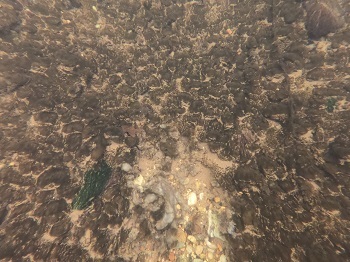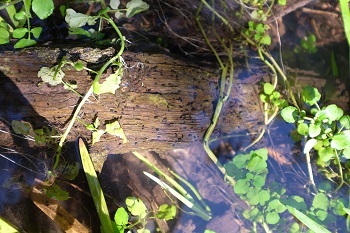|
This version has been corrected to include links to the MISIN website.
April 25, 2023
Contact: Joanne Foreman, 517-284-5814; Lucas Nathan, 517-599-9323; or Bill Keiper, 517-342-4087.
The flies are tied and rods and waders are ready as the April 29 statewide trout opener approaches.
Before heading out to that favorite fishing spot this season, the departments of Natural Resources and Environment, Great Lakes, and Energy are asking anglers to prepare for one more thing: decontamination.
Michigan?s trout streams are under increasing threat from harmful species that affect habitat and food sources for trout and other fish. Both didymo (rock snot) and New Zealand mudsnail can be moved to new locations on waders, nets and gear.
Didymo

Didymo is a microscopic diatom (single-celled alga) that thrives in cold, low-nutrient streams generally considered pristine. Under the right conditions, prolific growth, or blooms, result in thick mats that can cover river and stream bottoms, reducing habitat for macroinvertebrates including mayfly and caddisfly nymphs, which are important food for fish.
Didymo cells are believed to be native to at least parts of the Great Lakes basin; however, blooms are a recent phenomenon. Didymo blooms were first observed in Michigan waters in 2015 in the St. Marys River and then in the Manistee and Boardman rivers in 2021 and 2022, respectively. Scientists are still researching the causes of blooms. Regardless of its native/non-native status, didymo has the potential to spread to new areas when cells attach to anglers? waders and gear.
|
New Zealand mudsnail

New Zealand mudsnails are only about 1/8 inch long and can be difficult to see. However, these snails can change the aquatic habitats they live in by reaching extremely high densities. When that happens, they can outcompete native macroinvertebrates, leaving fish food in short supply. The mudsnails have no nutritional value, which can negatively affect the overall condition of fish that feed on them.
New Zealand mudsnail populations are known to be present in the Au Sable, Boardman, Grass, Pere Marquette, Pine and Upper Manistee rivers in Michigan. Mudsnails can survive out of water for several days. Because of their small size, they are easily transported on boats, anchors and fishing gear such as waders and nets.
|
Plan to decontaminate
To prevent these damaging species from hitchhiking on your waders and gear, make plans for decontamination before heading to the water.
Always Clean, Drain and Dry your waders, boots, boats and other gear between trips or before moving to a new body of water. Take extra precaution in areas with known or suspected didymo or New Zealand mudsnail infestations. In addition to removing debris and mud, the State of Michigan recommends using a chemical disinfectant to achieve maximum decontamination for didymo and New Zealand mudsnail. Possible disinfectants with documented effectiveness for these species include:
- Products such as Formula 409 Antibacterial All-Purpose Cleaner applied to waders and gear.
- Bleach: Apply a solution of one-half cup (4 fluid ounces) bleach to 5 gallons of water and let stand for 20 minutes.
- Virkon Aquatic: Apply a solution of 20 grams per liter of water and let stand for 20 minutes (see manufacturer?s label for additional guidance).
Any chemical disinfectants should be applied to waders and gear on land, at a reasonable distance from the water, to avoid accidental discharge into surface waters.
Research into the effectiveness of products such as Formula 409 Antibacterial All-Purpose Cleaner as a decontaminant for other aquatic species and diseases is ongoing. The Michigan Invasive Species Program will update its recommendations, as needed, based on the best available information to prevent the spread of aquatic invasive species.
Report new detections
Public reporting plays an important role in early detection of invasive and nuisance species. Anyone encountering suspected didymo or New Zealand mudsnail in new locations is asked to photograph and report the find.
To report didymo, use the Eyes in the Field online reporting system. Be sure to add up to three photos to aid in verification.
To report New Zealand mudsnail, make note of the location, date and time of the observation. This will aid in verification of your report. You may be asked to provide your name and contact information if follow-up is needed.
For more information on decontamination or aquatic invasive species, visit Michigan.gov/Invasives.
Michigan's Invasive Species Program is cooperatively implemented by the Department of Environment, Great Lakes, and Energy; the Department of Natural Resources; and the Department of Agriculture and Rural Development.
/Note to editors: Accompanying photos are available below for download. Suggested captions and photo credit information follow:
Manistee: Didymo growth on gravel in the Manistee River appears dark brown. Areas where thick growth sloughs off looks woolly and light tan, exposes clean substrate underneath. Photo courtesy of EGLE.
Debris: New Zealand mudsnails are visible on this woody debris near the mouth of Shanty Creek on the Grass River. Photo courtesy of Emily Burke, Grass River Natural Area, Inc./
|